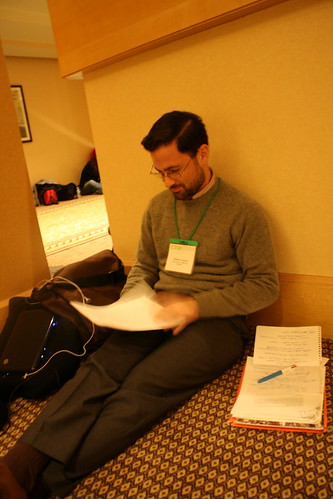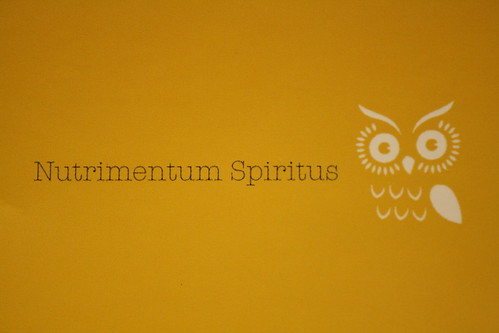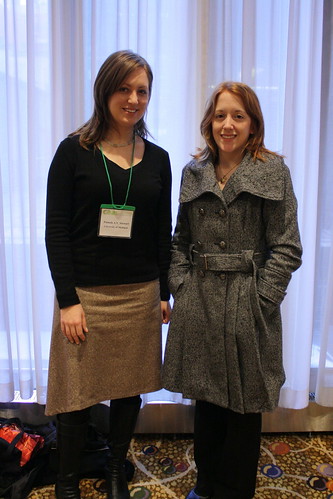Category Archives: Interviews
Clayton Merrell
Clayton Merrell grew up in Pittsburgh, PA, and Puerto Ordaz, Venezuela. He studied painting and printmaking at Brigham Young University and the Yale School of Art, where he earned an MFA in 1995. He received a Fulbright Grant to Oaxaca, Mexico in 1996-97. His work is exhibited and collected widely, with recent exhibitions at: The American Embassy in Belmopan, Belize; Slow Gallery, Chicago; The Roswell Museum and Art Center, Roswell NM; Concept Gallery, Pittsburgh PA; the A+D Gallery, Chicago; and the Chautauqua Institution, Chautauqua NY. He was the 2005 Artist of the Year at The Pittsburgh Center for the Arts, Pittsburgh PA. He has received awards and grants from the Pro-Arts Foundation, Skowhegan, the Millay Colony for the Arts, the Blue Mountain Center, the Vermont Studio Center, Artists Image Resource, and the Center for the Arts in Society. During 2004-05 he was a fellow at the Roswell Artist-In-Residence Foundation. He is currently an Associate Professor of Art at Carnegie Mellon University.
Dwayne Butcher: What brings you to CAA this year? Any particular panels, sessions or is it just a good reason to come to New York?
Clayton Merrell: This year for me, it is mostly a good excuse to come to New York? (Carnegie Mellon) is conducting preliminary interviews for our Sculpture position. It is always good to come and see people, people I have not seen in a long time.
DB: Can you talk about your experience of interviewing at CAA?
CM: I interviewed for many positions at CAA, back in the day. But, not for the position I have now. We actually just had a discussion in our department that we do not like to conduct interviews at CAA because it is such a weird environment. The amount of stress that everyone is under, it is almost unfair to the candidates, because of the pressure cooker quality of the conference. We find that people are more relaxed under different circumstances. That was certainly the case with my interviews.
DB: So, what kind of things are you working on in the studio?
CM: Right now I am working on these medium scale drawing/paintings that are prepatory works for large-scale paintings. I just bought a bunch of giant stretcher bars, 8′ and 6′ in length, to get ready for this summer. So, now I am working on these 22″ x 30″ sketches for the larger paintings, working through a lot of ideas. I am painting a lot of explosions, actually. Explosions are on the brain, exploding landscapes, combing very pretty, very delicate elements with some chaotic imagery.
DB: Talk about some of your upcoming activities? Do you have any future exhibition or travel plans?
CM: I am taking a sabbatical next year, so, I am looking forward to doing a lot of stuff, travel wise. I have a show this summer at the Chautauqua Institute in upstate New York. I have an exhibition at the Caseworks Project in Memphis, TN….
DB: Which will be the highlight of the year for Memphis.
CM: Oh, I assume so. I am also applying for several residencies and will probably head down to Mexico for a couple of months. I used to live in Mexico and look forward to going back for several months. I will do that and set up a show (in Mexico) for the work I will make while visiting.
DB: Is there a particular region or scenery that you prefer to visit that will benefit the work?
CM: I don’t know about for the work, really. Being in different places in general make there way into the work. I am not one of those people that travel around looking for inspiration.
DB: So, your landscapes are invented?
CM: They are totally made up. I do not use any photo references. I tried plein air once and it was a disaster. I took a large canvas outside once and hung it upside down on these two large posts and painted it like it was above me, like it was the sky. I thought it would be a funny twist on plein air painting, but it was a terrible painting.
DB: What is your favorite artist, book, color, smell and food.
CM: I hate these questions. I will do book first, Let’s Talk About Love by Carl Wilson. Artist? It depends on who I am looking at, at that moment. Food: Extremely spicy Mexican Food. Color: It is not an individual color but I combination of colors. I will have to show you swatches. Smell: Ha, I have no idea.
William Coleman’s Quick Thoughts on Representing Gothic

William L. Coleman, Ph.D. Candidate at UC Berkeley prepares for his session presentation at the Hilton New York. February 11, 2011. (Image Credit: Tempestt Hazel)
William L. Coleman, Ph.D. Candidate in History of Art at University of California, Berkeley:
I got a lot out of the session I attended yesterday morning called Representing Gothic, convened by Stephen Murray of Columbia [University] and [Andrew J. Tallon], an associate from Vassar [College]. There were also several perspectives on architectural, historical and traditional inquiry on the forms of Gothic architecture and perceptions of it later.
That was the session I got the most out of. There were some really interesting perspectives from Matilde Mateo of Syracuse University and Matthew Reeve of Queen’s University in Ontario. Really interesting, out-of-the-box thinking about the afterlives of this style, what it has meant and what it continues to mean.
Attend William Coleman’s session, Music and Other Paradigms for Nineteenth-Century Art, Part II, where he will be presenting Sibelius, Gallen-Kallela, and the Musical Landscape. Saturday, February 12, 2011, 2:30-5pm, Madison Suite, 2nd Floor, Hilton New York.
Career Talk
Walking into the Career Services Orientation on Tuesday evening, I was expecting a full house of anxious, anticipating job seekers. It seemed well attended on first glance. Held in the East Ballroom on the third floor of the Hilton, a very large room with a sea of sea foam green-colored chairs, it could have held hundreds.
Speaking to Emmanuel Lemakis, Director of Programs for CAA, and facilitator of the Orientation, he commented that his headcount was 100+, which I thought was quite a few. However, that number was below his expectations. Emmanuel remarked “this was the best showing of jobs and interviewers at CAA in years.” He expected more bodies filling more chairs.
With that in mind job seekers, here’s what you missed that may be useful to you on your job hunt!
For someone like myself, who has been to many conferences, chaired or participated on many career-oriented panels—or, as a former member of an academic administration involved in many stages of the faculty search process, the do’s and don’ts presented by the guest speakers seemed like second nature to me. Not so to many of the attendees in the audience. It made for much nervous and cautious laughter!
Presented by Sheila Pepe, Harriet Senie, and David Sokol, here are a few do’s and don’ts to keep in mind as you go through the interview process here at CAA:
Do’s
• Learn as much as you can about the school you are interviewing for, and its curriculum. Can we say GOOGLE?
• What is their culture?
• Speak in specific, anecdotal, rather than global, terms about your work.
• Ask smart questions, not global questions, about the institution.
• Instead of just selling yourself—listen. What does the institution need to build a better department?
• Do your homework: who are the faculty members & their work? How will your specialty fit into the curriculum?
• Assume an intelligent but uninformed audience when talking about your work during the interview.
• Ask to repeat the question if not understood the first time.
• Wear age-appropriate clothing. (David Sokol used ex: An artist wore an outfit with a light bulb on his head—a definite don’t!) And of course, if you are of a more “mature” age, wearing a mini skirt and mid-drift shirt just won’t fly with most committees nowadays–did they ever?
• Leave them feeling you are perfect for their department and their needs.
• Send a handwritten note after interview.
• The proper mindset: “You only need ONE job.”
Don’ts
• Underline things in your cover letter.
• Call institution about the search.
• Put personal information in application.
• Talk about personal or financial information at the interview.
• Bluff about credentials and knowledge in application.
• Be condescending to the institution.
• Insult interviewer’s intelligence.
• Crash alumni receptions of potential institutions at conferences (including CAA).
The best advice all the panelists gave: MAKE THEM LAUGH!
And if you have not already done so, pick up one of the green CAA Career Services Guides for the 2011 conference. It explains the services available for job seekers and employers alike, including the Candidate Center, the Online Career Center, and the Interview Hall. It also includes additional helpful hints and FAQ for job seekers and Employers.
Bridging the Gaps: MFA Candidate Leighann K. Wood

Image on the back of Leighann K. Wood's business card. February 9, 2011. (Photo Credit: Tempestt Hazel)
We all know about the sessions of the CAA Conference through the conference program–but what about the people filling the seats of the sessions? Who are they? In an effort to answer this question, I randomly asked welcoming faces sprinkled around the CAA to answer a few simple questions about themselves, what brings them to the conference and why they chose to pursue art history and scholarship. I will be conducting several of these interviews at random throughout the weekend.
Leighann K. Wood, Graduate Student of Library and Information Science, Information and Arts Consultant, Denver Colorado, First year attending CAA Conference
Tempestt Hazel: What brings you to the CAA Conference?
Leighann K. Wood: I did my undergraduate in Art History at West Michigan University. Then I moved out to Denver and I just started my Masters of Library and Information Management program at Emporia State University. I’m basically trying to incorporate the art world within more text-based institutions, bring more of that visual bridge into libraries and connecting those multi-cultural communities that don’t have the access that they need. For instance, a lot of museums have educational programs for kids but they leave those adults out. So, I’m trying to work towards that.
TH: What sessions and events are you excited about?
LW: Actually anything technology-based. I resisted that during my [time as an] undergrad.
TH: When you say technology-based, what do you mean exactly?
LW: Technology-based meaning blogs or wiki—even art databases. Especially in the art community, they think they need to know how to use it efficiently and not resist it because it’s here to stay.
TH: Finally, why art history? What is it that you love about art?
LW: Everything. I’m a visual learner so I think that the most appealing thing [about it] to me is the community that it brings together. I really want to transpose that into my own life but also bring it into my own community.
In From Michigan: Ph.D. Candidates Katharine Raff & Pamela A.V. Stewart

University of Michigan Ph.D. Candidates Pamela A.V. Stewart & Katharine Raff at the CAA Conference. February 9, 2011. (Image Credit: Tempestt Hazel)
We all know about the sessions of the CAA Conference through the conference program–but what about the people filling the seats of the sessions? Who are they? In an effort to answer this question, I randomly asked welcoming faces sprinkled around the CAA to answer a few simple questions about themselves, what brings them to the conference and why they chose to pursue art history and scholarship. I will be conducting several of these interviews at random throughout the weekend.
Katharine Raff, Ph.D. Candidate in the Department of History of Art at University of Michigan and Fellow at Metropolitan Museum of Art, first year attending CAA Conference
Pamela A.V. Stewart, Ph.D. Candidate in the History of Art at University of Michigan, third year attending CAA Conference
Tempestt Hazel: What brings you to the CAA Conference and why do you think it is important to be here?
KR: For me, because I study ancient art there really aren’t as many sessions dealing with that, but my career path is to work in museums, so I’m here for more of the sessions dealing with issues concerning museums. And in general, what’s going on in the field at large. Sometimes you get so inside of your own discipline, it’s nice to know what else is going on with art and artists.
PS: [I came] for the exchange of ideas. There aren’t a lot of panels that are specifically in line with my interests but there are some fabulous papers that are coming up. It’s really good to keep up with what is going on in the field, who is giving papers, where their interests are and people who matter—having that dialogue and exchange.
TH: What sessions and events are you most excited about?
KR: The was the one this morning, Making Museums Matter, Art & Commerce: The Art Gallery In America—really dealing more with museums and with ancient Italian art. I’m excited to hear Lauren Hackworth Petersen for the Italian Art Society session [and her paper] Why Have There Been No Great Roman Artists? I really like her work and I’m excited to hear what she has to say.
PS: I saw the session [Are We Standing at a Digital Divide in Art Publishing?] this morning, which was pretty interesting. I’m about to go to—well, I’m split between Architecture, Space and Power in the Early Modern Ibero-American World and The Crisis in Art History. There’s also going to be a paper [presented] by one of my old mentors—Elizabeth ‘Buffy’ Easton. She is the most powerful curator in the world—that’s her superhero name that she gives herself. Buffy is all-powerful. [laughs]
TH: My final question is why art or why art history? What drew you to the field?
KR: Even as a child my parents always took me to museums and I started learning about things, why they were created, how they were used and how they function. A lot of what I do is social history oriented and there’s always been that wanting to know how things function and why—not just that it’s a painting on a wall. How was it really used? How did it function in its particular historical moment? I think that’s so important to understand. I think a lot of people, unless they study art history, they don’t always get that. They go to a museum and think, “Oh, that’s cool” but when they really start to study it they learn about the very complex background of what caused it to be created and how it functioned. So, that’s why [I chose] art history. I think it plays such an important role in the humanities. We need to push that.
PS: Art is how we see ourselves. This is the most basic kind of communication that we have. This is how we see the world, the image we construct of the world and the image we project onto the world. I think Michael Baxandall was right [when he spoke about] positing an artwork as a deposit of a social relationship—you can’t always get that from a text. An image is immediate, as Leonardo would say. That’s why painting is better than poetry! [laughs]




